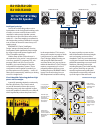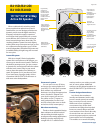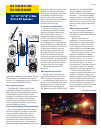
Page 2 of 5
Continued on next page
B215D/B212D/
B210D/B208D
15"/12"/10"/8" 2-Way
Active PA Speaker
Intelligent by design
One of the coolest things about active
loudspeakers is the lack of back-breaking racks
of amps, crossovers and EQs that are often
required to make passive speaker systems
sound almost as good. But that comes with a
trade-off — that extra weight is transferred to
the loudspeaker, making it diffi cult for a single
user to heave all that mass onto the top of a
speaker stand.
BEHRINGER’s D Series’ “Intelligent-
Design” merges the best features of active
loudspeakers with signifi cantly lower weight
by using switch-mode power supplies and
Class-D amplifi er topology.
Hidden deep inside each enclosure is
the equivalent of an active 2-way electronic
crossover, graphic EQ, parametric EQ, mic
preamp, limiter and two Class-D power
amplifi ers, yet overall weight is less than
comparable loudspeaker systems! These
components work together seamlessly to
provide optimum sound quality — and it all
takes place automatically, without you having
to touch a single knob.
Class D Amplifi er Technology delivers high
power with low weight.
Instead of operating relatively continuously
like Class AB circuits, Class D amps switch
on and off thousands of times per second,
delivering power only when needed. In other
words, the amplifi er is either fully on or fully off ,
which signifi cantly reduces the power losses
INPUT
LINK
OUTPUT
INPUT
LINK
OUTPUT
Output Right
EUROLIVE B215D
EUROLIVE B215D
XENYX 2442FX
Output Left
INPUT
¼" input jack for
balanced TRS and
unbalanced TS
connections.
MIC/LINE input
jack with internal
microphone
preamplifi er for
balanced XLR
connections.
LINK OUTPUT
XLR jack lets you
connect additional
BEHRINGER active
loudspeaker
systems.
LEVEL control
with CLIP LED for
optimizing input
signal level.
EQ HIGH &
LOW shelving
equalization
controls cuts or
boosts the treble
(12kHz) and bass
(80Hz) range by
15 dB.
Power LED.
in the output devices. This is easy in
theory and complex in practice, which
is why there are so many diff erent
Class D designs. Without boring you
with terms like PWM Generation
and Gate Drivers, let’s just say that to
realize the benefi ts of a Class D design
requires compensating for a lot of
potential problems that can cause
audible distortion. BEHRINGER didn’t
invent Class D technology, but our
R&D Department has been working
for years to perfect our own version
with all the benefi ts of reduced weight
and cool running, and none of the
drawbacks. That’s why we invested over
a solid year of research time eliminating
pitfalls like quantizing errors and excess
dead time, selecting just the right
switching frequency (and other equally
tech-y terms). And why we spent an
equally long time testing individual
components to ensure they will stand
up to the rigors of the real world.







